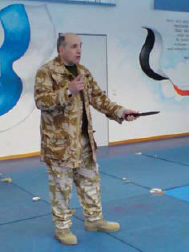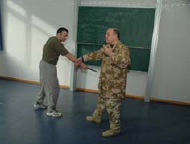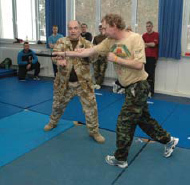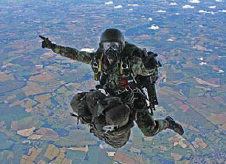If you plump for a revolver, any well-made .38 Special is a good all round choice being more powerful than the .38 and utterly reliable.
KNIVES
Keep your knife for cutting your steak. Probably the only time you will use one in anger is in a bar-room brawl. You are even less likely to use a knife to kill an enemy soldier than you are a pistol. The best reason for carrying a Ka-Bar or Bowie knife is to ‘look the part’. But I want to make you a better soldier not look like an extra from Rambo. Like any other weapon, if you are in a hostile crowd on patrol a knife could be taken and used against you. Easier than most things if it is in a sheath on your hip or webbing. Don’t offer the target.
Knives do come in handy as a tool or as a weapon but the best type to carry is a lock-knife. Perhaps with a saw and screwdriver built in. This is a folding knife which locks open to prevent it closing on your fingers. It can be carried discretely in the pocket where it will not be snatched in a crowd and it can do all the things you need in the field like cutting string and sharpening wooden stakes.
Goal: When is the right time to employ this weapon? What is it good for?
The one time you might want to use a knife against someone is when you are undercover and unable to carry a gun on the grounds of being unable to hide one. A tiny lock-knife with a 2in blade is plenty to kill with if you use it right.
You have no chance against an opponent with a pistol or even a stick if you have just a knife. The use of a knife in combat should be a surprise rather than facing up against an opponent if you can possibly manage to arrange things that way.

The Author teaching knife fighting.
Given you have the element of surprise, you can cut the carotid artery with a short knife and cause death within a couple of seconds. Insert the knife in the side of the neck with the blade pointing to the front and cut forwards. This is messy. Given a longer knife, if you approach from behind and put one hand around the head the target will raise both hands to give you a clear shot at his belly, Slide the knife upwards and tear to cause maximum blood loss. A knife over about 9in will easily reach the heart.

Surprise is everything when you need to take a knife.

Take the elbow, then the wrist and then turn the knife back on your enemy. (Author’s Collection)
The only way to defeat a knife safely, every time, without carrying a weapon yourself is to wear Kevlar gloves and shirt then grab the knife blade. It works surprisingly well. If you could carry a baton, however, it would be a simple matter to break the wrist of an opponent with a knife. I carry a telescopic metal baton.
Skill: How do you use the weapon to maximum efficiency?
I have only ever used a knife once in military combat and it would have been much less messy to have used my fists or a rock. If you have to carry a fighting knife, choose a knife with a good grip on the handle as blood is very slippery and you don’t want to drop it. Speed and reach is important so go for a light knife which is as long as you can carry. The point is for killing so the blade should be slender for better penetration through heavy clothing or webbing.
Don’t draw or show your knife unless you are going to use it. Keep it hidden until you are about to strike. Keeping the knife hidden can give you the element of surprise. If you lose that and it comes to a ‘face-off’ lead with the knife like a sword-fencer if your opponent has a knife and guard the knife with your free hand and body if he doesn’t. My main concern with you carrying a knife is that some people are shy of using them. Showing a knife to deter an attacker in a civilian situation can get you killed if you can’t or won’t use it. This is doubly true in a military situation. A knife enters the human body with the slightest touch and opens up the flesh without any obvious resistance. But there is always lots and lots of blood and the target’s guts often drop out – so get used to the idea.
There are three principle cuts to kill with a knife. It takes a long knife to reach up to the heart from the navel. It takes a long thin knife to go through the ribs from the back and to the heart without sticking. It takes only a box-cutter, as they call them in the United States, (Stanley Knife in the UK) to cut the carotid artery or vein with a horizontal, deep, forward-moving stroke on either side of the neck.
After the events of 9/11 I hope you will not underestimate box-cutters – especially when they may be brought out as a surprise. Many years ago in a bar fight a chap caught me on the top of the arm just below the elbow with a box cutter. I didn’t feel a thing but the flesh opened up like a pair of lips and I lost the use of the arm for the duration of the fight. The medic had to stitch up the muscle and tendon inside the arm before stitching up the surface. I just have a 3in scar now but against a better opponent, out to kill me, the next hit could have been fatal. Remember: don’t drink and fight – it’s worse than drinking and driving.
If you are attacked by someone with a knife then distance is all important – as with all contact sports – especially if you don’t have a knife on you. Maintaining a distance will ensure that your opponent has to step forward to touch you. This feels awkward initially but it will give you ‘thinking time’ to dodge or counter the strike. An open coat held like a bull-fighter can also be useful.
Let the strike follow through on its swing as you step out of the way then move in with a jab to the eyes or a blow to the jaw. It’s not simple and it won’t work every time but then it is better than nothing. If you have a knife this is the one time you can use the edge of the blade – you slice your opponents knife arm at the wrist or forearm as he reaches out to strike you. This way you can maintain maximum distance and avoid injury yourself.
Types of knives
The Bowie knife and Ka Bar are good examples of a large solid knife which is handy for camping and will kill someone efficiently if you can hide it from them first. A lock-knife with a 6in, or even a 3in blade is just as deadly, just as useful and much easier to hide.
Summary: What are the important things to remember about knives?
Carry a small lock-knife on operations to use as a tool. It should be light and easy to hide out of sight so it cannot be taken from you in a crowd situation. As a weapon, the knife is always a last resort for a soldier or undercover operator. A weapon to use when there is nothing else. In a face-off you have a far better chance armed with a stout stick but a small knife can be carried when nothing else can. Try not to get into that situation.
MAPS AND GPS
There is no point in my giving you a map reading lecture here: you should all have a GPS system (if not invest in one). They never break down and cannot be jammed by the enemy. Actually, for the innocents reading this book, that last sentence is a lie. All tech kit breaks down and most can be disrupted by electronic counter-measures when it suits someone with the ability. Without your GPS and behind enemy lines you had just better be able to navigate with a map and the stars.

Tom exits the aircraft posing like a film star: when you are all alone and behind enemy lines you really need to know what you are doing with a map. (Photo courtesy Tom Blakey)
Anyone can read a map – rivers and roads and forests are just drawn on it and there is a legend in the corner which explains everything. It is just transferring the information to the ground and back that takes practice. What I mean is reading a map is easy if it has roads and other useful features on it. Some maps just have endless desert, bush or jungle with, and if you are lucky, a few contours or distant mountains. So they aren’t much more than a blank sheet. The less information there is on the map the harder it is to find out where you are and where you are going. There used to be a map of a tank training area in Canada which covered thousands of square miles and had only one tree on it in the middle. Then a drunken British tank driver drove over the tree... What I shall do is give you a handful of tips relating to navigation that have come in handy for me.